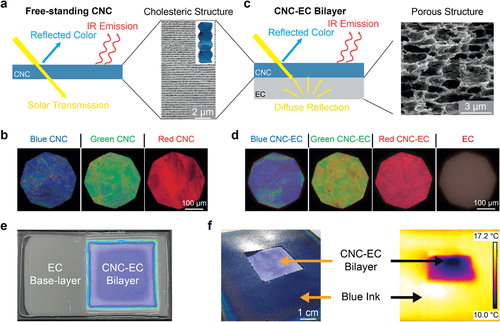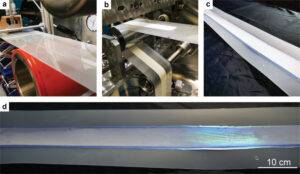Switching on the fan, cooler, or AC is the simplest way to escape heat waves outside. However, all of these consume a certain energy level and have quite a share in emitting harmful greenhouse gas. Researchers Silvia Vignolini & Qingchen Shen and their team have devised “plant based colorful cooling films” that can actively contribute to lowering the room temperature. Thus adding an adequate cooling effect without electricity. The base component is derived from the cellulose nanocrystals (CNCs) naturally found within plants and can be transformed into films with color irrespective of any additional pigment.
Silvia Vignolini says that materials that reflect a lot of solar light help with thermal management without absorbing the heat. However, there are very few materials that can offer such help. Most of the time, adding color to them alters the level of cooling effect.
Further, Qingchen Shen states that multiple sheets and paints with PDRC technology are used today. However, they do not have different color options. Adding in color causes the same to absorb pigments from the sunlight, leading to unwanted warming of the indoors.
What is Passive Daytime Radiative Cooling (PDRC)?
Passive daytime radiative cooling (PDRC) is the ability of a surface to reflect its heat to the space without absorbing it. As a result, the surface cools down multiple degrees without external electric-based cooling elements. By using such materials in buildings, people can save on energy.
The Foundation Of Plant Based Colorful Cooling Films
Have you ever encountered a soap bubble emitting a prism of colors on the surface? The very reason for such a phenomenon is the way light interacts with the thickness of the bubble. Otherwise known as structural color, this was the base of Silvia Vignolini’s research. Where the team was trying to find out the various types of structural colors.
On one such occasion, the research team discovered how cellulose nanocrystals from the natural plant cellulose could be created into colorful films with added pigments. These offer a natural PDRC effect and help with thermal management.
Creating Plant Based Colorful Cooling Films -The Backdrop
When investigating PDRC films, researchers came across options in mirror-like appearance or plain white. Adding some colors affects the overall productivity of the same. Also, there are instances of utilizing Tamm resonance structures combined into multiple selective emitters. However, such an arrangement did come with specific drawbacks, where it was essential for the creators to exert adequate control over the thickness. This made it hectic to curate photonic structures (on a large scale).

To avoid absorption-based heating issues, manufacturers went forward with structural coloration. This included colored DRC (Daytime Radiative Cooling) materials, utilizing a silica opal structure. But the effect was not that great, and the same comprised monodisperse nanoparticles which proposed a challenge on the cost-effective manufacturing scale.
Effectivity of Cellulose Nanocrystals (CNCs)
Cellulose Nanocrystals (CNCs) came as a great relief. These were extracted from wood and cotton pulp (completely renewable). After extraction, the same were dispersed into water, where the CNCs went into a self-organization mode of colloidal liquid crystals. The arrangement, when dry, emitted a complete reflection of the visible light.
Creating Plant Based Colorful Cooling Films
As part of the research, the team layered the CNCs with another white-colored material made from EC (Ethyl Cellulose). This together stood for a colorful but bilayer PDRC film. The films came in red, green, and blue colors, which were cooler by 7 degrees Fahrenheit under the sunlight than the air surrounding them.

120 watts of cooling power is generated from a square meter of the film. At first, the research team found it challenging to stick the CNC and EC together. Later they were able to come up with a rightful solution, manufacturing several meters of the film.
Appropriate field experiments were conducted on the rooftop of Purdue University’s Herrick Lab (between 2021’s July and 2022’s May). The films were kept in a suspended mode to avoid parasite heating from the environment. Other tests include:
- Sheer stress test
- Measurement of mechanical strength
- Cross hatch adhesion test
- Determination of morphology and thickness
Real-Life Implications Of Plant Based Colorful Cooling Films
Since its invention, the team has been focusing on the aesthetics of the film. They are now more into offering various glittery and colorful options, with wood finishes that add to the interior of the building.
The team also suggests that CNCs can be an active material in sensors to detect pollutants and weather changes. Imagine a building in a car-dense urban area comprising plant based colorful cooling films with inbuilt detectors. Daily, the same will be able to alert officials of the smog outside and save them from the heat waves.



